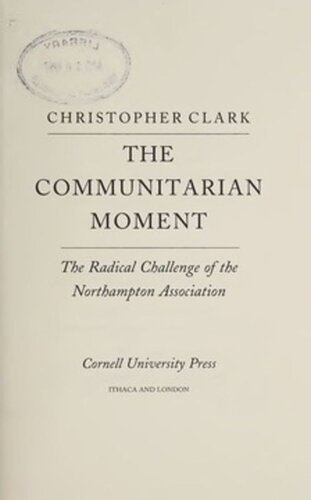

Most ebook files are in PDF format, so you can easily read them using various software such as Foxit Reader or directly on the Google Chrome browser.
Some ebook files are released by publishers in other formats such as .awz, .mobi, .epub, .fb2, etc. You may need to install specific software to read these formats on mobile/PC, such as Calibre.
Please read the tutorial at this link: https://ebookbell.com/faq
We offer FREE conversion to the popular formats you request; however, this may take some time. Therefore, right after payment, please email us, and we will try to provide the service as quickly as possible.
For some exceptional file formats or broken links (if any), please refrain from opening any disputes. Instead, email us first, and we will try to assist within a maximum of 6 hours.
EbookBell Team

5.0
58 reviewsIn 1842 a group of radical abolitionists formed a community in Northampton, Massachusetts, in order to pioneer "a better and purer state of society." Calling themselves the Northampton Association of Education and Industry, they envisioned a world free of poverty and inequality, religious intolerance, slavery and racial injustice. In telling the fascinating and little-known history of the Association, Christopher Clark offers insights into the "communitarian moment" of the 1840s which saw the establishment of dozens of utopian communities by Americans determined to challenge the tenets of their society. One of the few places in mid-nineteenth-century America where white and black people could live as equals, the Northampton community was home to almost two hundred and fifty men, women, and children during its four and a half years of existence. The membership comprised an unusual collection of individuals, among them small manufacturers, abolitionist lecturers, teachers, craftsmen, laborers, and former slaves, including Sojourner Truth. Offering biographical sketches of a variety of intriguing characters, Clark describes the inhabitants' daily routines, their struggle to support themselves through the production of silk, the roles of men and women, and tensions among members of different cultural backgrounds. Finally, he looks at the reasons for the closing of the community and follows the lives of its members, recounting the subsequent softening of their political convictions. Throughout his masterful narrative, Clark views the Northampton Association in its wider social and cultural context. He shows how, by attempting to initiate radical change, the Association and other utopian groups tested the ideological limits of antebellum society. Clark helps us understand both the significance of their vision and what was lost when that vision was abandoned.